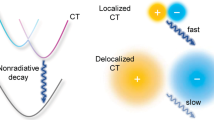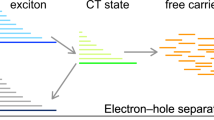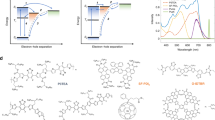Abstract
The standard picture of photovoltaic conversion in all-organic bulk heterojunction solar cells predicts that the initial excitation dissociates at the donor/acceptor interface after thermalization1,2,3,4,5,6,7,8,9,10,11,12. Accordingly, on above-gap excitation, the excess photon energy is quickly lost by internal dissipation2,3,11,13,14,15,16. Here we directly target the interfacial physics of an efficient low-bandgap polymer/PC60BM system. Exciton splitting occurs within the first 50 fs, creating both interfacial charge transfer states (CTSs) and polaron species. On high-energy excitation, higher-lying singlet states convert into hot interfacial CTSs that effectively contribute to free-polaron generation. We rationalize these findings in terms of a higher degree of delocalization of the hot CTSs with respect to the relaxed ones, which enhances the probability of charge dissociation in the first 200 fs. Thus, the hot CTS dissociation produces an overall increase in the charge generation yield.
This is a preview of subscription content, access via your institution
Access options
Subscribe to this journal
Receive 12 print issues and online access
$259.00 per year
only $21.58 per issue
Buy this article
- Purchase on Springer Link
- Instant access to full article PDF
Prices may be subject to local taxes which are calculated during checkout





Similar content being viewed by others
References
Clarke, T. M. & Durrant, J. R. Charge photogeneration in organic solar cells. Chem. Rev. 110, 6736–6767 (2010).
Cowan, S. R., Banerji, N., Leong, W. L. & Heeger, A. J. Charge formation, recombination, and sweep-out dynamics in organic solar cells. Adv. Funct. Mater. 22, 1116–1128 (2012).
Grancini, G. et al. Influence of blend composition on ultrafast charge generation and recombination dynamics in low band gap polymer-based organic photovoltaics. J. Phys. Chem. C 116, 9838–9844 (2012).
Di Nuzzo, D. et al. Improved film morphology reduces charge carrier recombination into the triplet excited state in a small bandgap polymer-fullerene photovoltaic cell. Adv. Mater. 22, 4321–4324 (2010).
Jarzab, D. et al. Low-temperature behaviour of charge transfer excitons in narrow-bandgap polymer-based bulk heterojunctions. Adv. Energy Mater. 1, 604–610 (2011).
Grancini, G. et al. Transient absorption imaging of P3HT: PCBM photovoltaic blend: Evidence for interfacial charge transfer state. J. Phys. Chem. Lett. 2, 1099–1105 (2011).
Hwang, I. W. et al. Ultrafast electron transfer and decay dynamics in a small band gap bulk heterojunction material. Adv. Mater. 19, 2307–2312 (2007).
McMahon, D. P., Cheung, D. L. & Troisi, A. Why holes and electrons separate so well in polymer: fullerene photovoltaic cells. J. Phys. Chem. Lett. 2, 2737–2741 (2011).
Etzold, F. et al. The effect of solvent additives on morphology and excited-state dynamics in PCPDTBT: PCBM photovoltaic blends. J. Am. Chem. Soc. 134, 10569–10583 (2012).
Jamieson, F. C. et al. Fullerene crystallisation as a key driver of charge separation in polymer/fullerene bulk heterojunction solar cells. Chem. Sci. 3, 485–492 (2012).
Bakulin, A. et al. The role of driving energy and delocalized states for charge separation in organic semiconductors. Science 335, 1340–1344 (2012).
Petrozza, A., Laquai, F., Howard, I. A., Kim, J. S. & Friend, R. H. Dielectric switching of the nature of excited singlet state in a donor-acceptor-type polyfluorene copolymer. Phys. Rev. B 81, 205421 (2010).
Fazzi, D. et al. Ultrafast internal conversion in a low band gap polymer for photovoltaics: experimental and theoretical study. Phys. Chem. Chem. Phys. 14, 6367–6374 (2012).
Lee, J. et al. Charge transfer state versus hot exciton dissociation in polymer—fullerene blended solar cells. J. Am. Chem. Soc. 132, 11878–11880 (2010).
Shoaee, S. et al. Acceptor energy level control of charge photogeneration in organic donor/acceptor blends. J. Am. Chem. Soc. 132, 12919–12926 (2010).
Howard, I. A., Mauer, R., Meister, M. & Laquai, F. Effect of morphology on ultrafast free carrier generation in polythiophene: fullerene organic solar cells. J. Am. Chem. Soc. 132, 14866–14876 (2010).
Peet, J. et al. Efficiency enhancement in low-bandgap polymer solar cells by processing with alkane dithiols. Nature Mater. 6, 497–500 (2007).
Herrmann, D. et al. Role of structural order and excess energy on ultrafast free charge generation in hybrid polythiophene/Si photovoltaics probed in real time by near-infrared broadband transient absorption. J. Am. Chem. Soc. 133, 18220–118233 (2011).
Singh, S. et al. Two-step charge photogeneration dynamics in polymer/fullerene blends for photovoltaic applications. Phys. Rev. B 85, 205206 (2012).
Deschler, F. et al. Reduced charge transfer exciton recombination in organic semiconductor heterojunctions by molecular doping. Phys. Rev. Lett. 107, 127402 (2011).
Jamieson, F. C., Agostinelli, T., Azimi, H., Nelson, J & Durrant, J. R. Field-independent charge photogeneration in PCPDTBT/PC70BM solar cells. J. Phys. Chem. Lett. 1, 3306–3310 (2010).
Köhler, A. et al. Charge separation in localized and delocalized electronic states in polymeric semiconductors. Nature 392, 903–908 (1998).
Cabanillas-Gonzalez, J., Grancini, G. & Lanzani, G. Pump-probe spectroscopy in organic semiconductors: Monitoring fundamental processes of relevance in optoelectronics. Adv. Mater. 23, 5468–5485 (2011).
Brida, D., Manzoni, C., Cirmi, G., Polli, D. & Cerullo, G. Tracking ultrafast energy flow in molecules using broadly tunable few-optical-cycle pulses. IEEE J. Sel. Top. Quantum Electron. 18, 329–339 (2012).
Brida, D. et al. Generation of 8.5-fs pulses at 1.3 μm for ultrabroadband pump-probe spectroscopy. Opt. Express 17, 12510–12515 (2009).
Liu, T., Cheung, D. L. & Troisi, A. Structural variability and dynamics of the P3HT/PCBM interface and its effects on the electronic structure and the charge-transfer rates in solar cells. Phys. Chem. Chem. Phys. 13, 21461–21470 (2011).
Hiroyuki, T., Ramon, J. G. S., Bittner, E. R. & Burghardt, I. Phonon-driven exciton dissociation at donor-acceptor polymer heterojunctions. Phys. Rev. Lett. 100, 107402 (2008).
Huang, Y. et al. Electronic structures of interfacial states formed at polymeric semiconductor heterojunctions. Nature Mater 7, 483–489 (2008).
Crespo-Otero, R. & Barbatti, M. Spectrum simulation and decomposition with nuclear ensemble: Formal derivation and application to benzene, furan and 2-phenylfuran. Theo. Chem. Acc. 131, 1237–4 (2012).
Troisi, A. Charge transport in high mobility molecular semiconductors: Classical models and new theories. Chem. Soc. Rev. 40, 2347–2358 (2011).
Yost, S. R., Wang, L. P. & Van Voorhis, T. Molecular insight into the energy levels at the organic donor/acceptor interface: A quantum mechanics/molecular mechanics study. J. Phys. Chem. C 115, 14431–14436 (2011).
Spadafora, E. J., Demadrille, R., Ratier, B. & Grévin, B. Imaging the carrier photogeneration in nanoscale phase segregated organic heterojunctions by Kelvin probe force microscopy. Nano Lett. 10, 3337–3342 (2010).
Brédas, J-L., Norton, J. E., Cornil, J. & Coropceanu, V. Molecular understanding of organic solar cells: The challenges. Acc. Chem. Res. 42, 1691–1699 (2009).
Frisch, M. J. et al. Gaussian 09, Revision A.1 (Gaussian, Inc., 2009).
Acknowledgements
G.C. acknowledges financial support from the PRIN programme 2008JKBBK4. D.F. thanks M. Barbatti of the Max-Planck-Institut für Kohlenforschung for useful discussions.
Author information
Authors and Affiliations
Contributions
Data were taken by and analysed by G.G., M.M., A.P. and D.B. The experiments were conceived by G.L., G.G., G.C. and H-J.E. Quantum chemical calculations were carried out by D.F. Samples were prepared by G.G. All authors contributed to the writing of the paper.
Corresponding author
Ethics declarations
Competing interests
The authors declare no competing financial interests.
Supplementary information
Supplementary Information
Supplementary Information (PDF 2298 kb)
Rights and permissions
About this article
Cite this article
Grancini, G., Maiuri, M., Fazzi, D. et al. Hot exciton dissociation in polymer solar cells. Nature Mater 12, 29–33 (2013). https://doi.org/10.1038/nmat3502
Received:
Accepted:
Published:
Issue Date:
DOI: https://doi.org/10.1038/nmat3502
This article is cited by
-
Physical insights into non-fullerene organic photovoltaics
Nature Reviews Physics (2024)
-
Driving force and nonequilibrium vibronic dynamics in charge separation of strongly bound electron–hole pairs
Communications Physics (2023)
-
Organic long-persistent luminescence stimulated by visible light in p-type systems based on organic photoredox catalyst dopants
Nature Materials (2022)
-
Sub-10-fs observation of bound exciton formation in organic optoelectronic devices
Nature Communications (2022)
-
Semitransparent organic photovoltaics for building-integrated photovoltaic applications
Nature Reviews Materials (2022)



